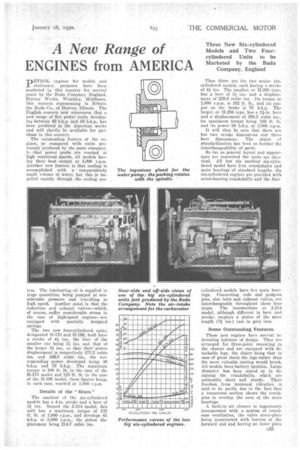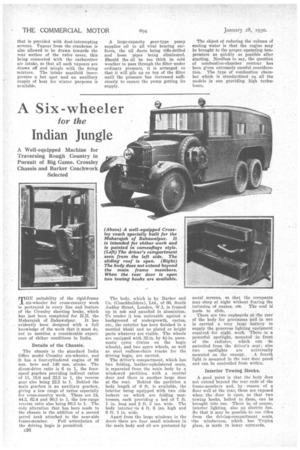A New Range of ENGINES from AMERICA
Page 57

Page 58

If you've noticed an error in this article please click here to report it so we can fix it.
Three New Six-cylindered Models and Two Foureylindered Units to be Marketed by the Buda Company, England pETHOL engines for mobile and stationary purposes have been marketed in this country for several years by the Buda Company England, Harvey Works, Wembley, Middlesex, this concern representing in Britain the Buda Co., of Harvey, Illinois. The English concern now announces that a new range of five power units, developing between 49 b.h.p. and 86 b.h.p., has been Produced at the _American works and will shortly be available for pnrchase in this country.
The outstanding feature of the engines, as compared with units previously produced by the same company, is that power peaks are reached at high rotational speeds, all models having their best output at 3,000 r.p.m. Another new feature is that cooling is accomplished with a comparatively small volume of water, but this is impelled rapidly through the cooling eye tem. The lubricating _oil is supplied in large quantities, being pumped at considerable pressure and travelling at high speed. Another point is that the induction and exhaust valves—which, of course, suffer considerable stress in the case of high-speed engines—are equipped with specially designed springs.
The two new four-cylindered units, designated If-173 end 11-199, both have a stroke of 4.1, ins., the bore of the smaller one being 3i ins, and that of the larger 34 ins., so that their piston displacement is respectively 173.2 cubic ins. and 199.8 cubic ins., the corresponding power developed being 49 b.h.p. and 57 b.h.p. The maximum torque is 108 ft. lb. in the ease of the 11-173 model and 125 ft. lb. in the ease of the H-199 model, these figures being, in each case, reached at 1,000 r.p.m.
Details of the "Sixes:"
The sniallest of the six-eylindered models has a 4-in, stroke and a bore of 3g ins. Named the J-214 model, this unit has a maximum torque of 135 ft. lb. at 1,000 r.p.m., and develops 61 b.h.p. at 3,000 r.p.m., the piston displacement being 214.7 cubic ins. Then there are the two senior sixeylindered models, each having a stroke of 4-i ins. The -smaller, or H-260 type, has a bore of 31.,7 ins. and a displacement. of 259.9 cubic ins. ,Its torque at 1,000 r.p.m. is 162 ft. lb., and its coltput on the brake is 75 b.b.p. The larger, or 11-298 type, has a 31-in. bore and a displacement of 298.2 cubic ins., its maximum torque being 186 ft. lb. and its power 86 b.h.p. at 3,000 r.p.m.
It will thus be seen that there are but two stroke dimensions and three bore dimensions. The object ef standardization has been to further the interchangeability of 'parts.
So far as general layout and appearance are concerned the units are identical. All but the smallest six-cylindered model have 3-in. crankshafts and main bearings of standard lengths, the six-eylindered engines are provided with seven-bearing crankshafts and the four cylindered models have five main bearings. Connecting rods and gudgeon pins, also inlet and exhaust valves, are interchangeable throughout these four types. The intermediate or 3-214 model, although different in bore and stroke, employs a piston of the same length (21 ins.) cast in grey iron.
Some Outstanding Features.
These new engines have several interesting features of design. They are arranged for three-point mounting in the chassis and are equipped with detachable legs, the object being that in case of great shock the legs rather than the more valuable casting would break. All models have battery ignition. Large diameter has been aimed at in designing the crankshafts, which are noticeably short and sturdy. Their freedom from torsional vibration is said 'to be partly due to the fact that a transverse section shows the crankpins to overlap the area of the main bearings.
A blt-in air cleaner is ingeniously incorporated with a system of crankcase ventilation, the valve cover-plate being constructed with louvres at the forward end and having an inner plate that is provided with dust-intercepting screens. Vapour from the crankcase is also allowed to be drawn towards the rear section of the valve cover, this being connected with the carburetter air intake, so that all such vapours are drawn off and mingle with the firing mixture. The intake manifold incorporates a hot spot -land an auxiliary supply of heat fur winter purposes is available.
A large-capacity gear-type pump supplies oil to all vital bearing surfaces, the oil ducts being rifle-drilled and kose pipes being eliminated. Should the oil be too thick in cold weather to pass through the filter under ordinary pressure, it is arranged co that it will pile up on top of the filter until the pressure has increased sufficiently to ensure the primp getting its supply.
The object of reducing the volume of cooling water is that the engine may be brought to the proper operating temperature as quickly as possible after starting. Needless to Ray, the question of combustion-chamber contour has been given extremely careful consideration. The type of combustion chamber which is standardized on all the models is one providing high turbuknee,












































































































